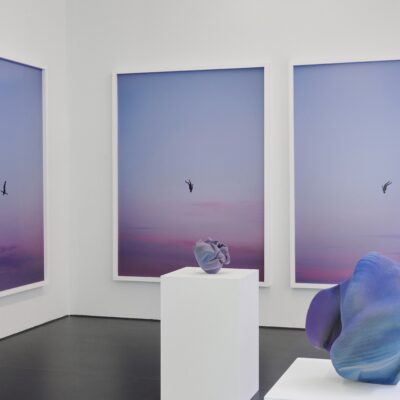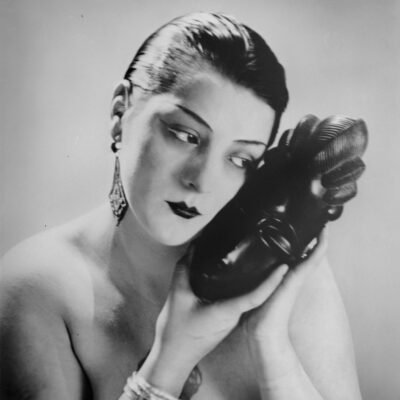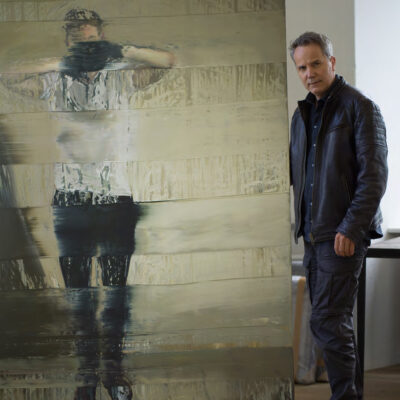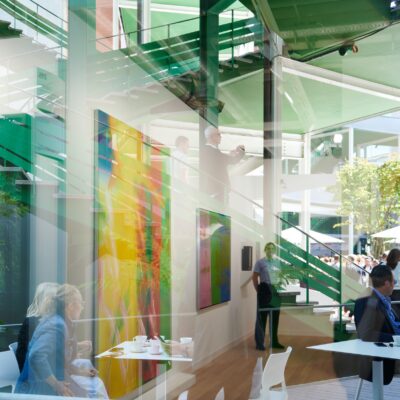The year 2022 is off to an auspicious start for the Photo Elysée Museum in Lausanne. The institution’s fund is enriched by an exceptional donation of 100 vintage photographs by David Douglas Duncan (1916-2018) from a private collection. Taken between 1956 and 1973, these images bear precious witness to the friendship that united the American photographer and the painter Pablo Picasso. Tatyana Franck, outgoing director of Photo Elysée, should be delighted. 10 years ago, a magnificent exhibition was held at the Musée d’art et d’histoire entitled Picasso at work, through the lens of David Douglas Duncan. The public discovered the Maestro in his intimacy through photos and various works of art. Tatyana Franck was one of the scientific curators. The loop is somehow closed.

David Douglas Duncan, Pablo Picasso signant une toile, 1960 © David Douglas Duncan_Succession Picasso 2022
The meeting: a friendly thunderbolt
In February 1956, Douglas Duncan, whose fame was already well established, was in Cannes in transit to Morocco for a report on the Berbers of the Atlas. His friend and great war reporter Frank Capa had recommended that he contact Picasso. Staying in a hotel, Duncan somehow manages to obtain the telephone number of California, the residence of the artist. On the phone, Jacqueline Rocque, Picasso’s companion, invited him without hesitation to join them. The photographer does not waste a minute and shows up at their door without suspecting what will happen next. It is the 8th of February and the Catalan Maestro receives him sitting in his bathtub, naked, and all smiles. Douglas Duncan captures this moment on film, the first photo of a very long series of several thousand. It is a mythical photo that seals a 17-year friendship between the two men based on mutual admiration and respect. Art entered Douglas Duncan’s life through the front door. While other renowned photographers have taken Picasso’s portrait, the American has the privilege of having shared his intimate family life and his moments of creation until the death of the painter in 1973.

David Douglas Duncan, Duncan posant aux côtés du portrait de Picasso, 1981©Judy Caravaglia_Succession Picasso 2022
The place of photography in Picasso’s life
Picasso’s portraits on film are legendary. No wonder his charisma has inspired renowned photographers such as Brassaï, André Doisneau, Man Ray, his muse Dora Maar, Lucien Clergue. All were captivated by his dark gaze and physical presence like no other. Picasso had an ego the size of his genius and he knew how to play with it in front of the lens. He also took photographs all his life. His first attempts date from 1899-1900 in Horta de Sant Joan in Catalonia. Photography is also an integral part of his creative process, fueling his inspiration, his taste for staging, and above all an essential tool for documenting his life. This is evidenced by this comment to Brassaï in 1932: “Why do you think I date everything I do? It is not enough to know the works of an artist. You also have to know when he did them, why, how, under what circumstances.” In the 1950s, Picasso collaborated with photographers according to his artistic projects. André Villers for the cutouts and photo collages. Gjon Mili of Life Magazine immortalizes a series of luminous drawings made by the painter in a dark room, capturing some unreal shots.

David Douglas Duncan, Jacqueline portant le collier en céramique, 1957 © David Douglas Duncan_Succession Picasso 2022
Two men at opposite extremes
Douglas Duncan, the adventurer, captured images of conflicts around the world on film. During the second war, he joined the Marines and was sent to the South Pacific for National Geographic Magazine. Life Magazine recruited him in the early 1950s and he became the eyes of the world for, among other things, the Korean War (1950-1953) and the Vietnam War. Is the meeting with Picasso predestined, knowing that the painter nicknamed him Ishmael (God listens)? For Picasso, Douglas Duncan embodies fearlessness, courage, and he was a great admirer of his career. Yet their approach to life seems to be poles apart. Picasso lived like a recluse in his property, and built a safety cordon around him. Douglas Duncan became a nurturing link with the outside world through his travels. Their correspondence is regular and provides the painter with information on world affairs.
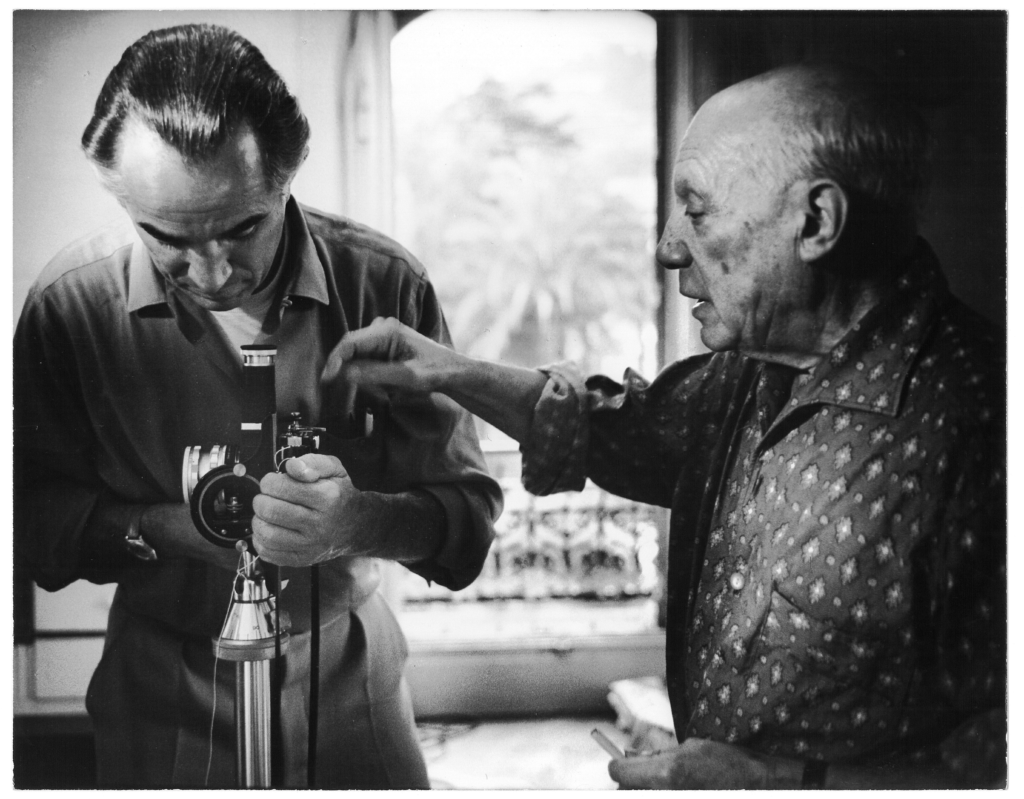
David Douglas Duncan, Pablo Picasso et David Douglas Duncan, 1959 © Gjon Mili_Succession Picasso 2022
What do Douglas Duncan’s photos tell us about the artist, a brilliant jack-of-all-trades?
The photographer, impressed at first, very quickly established a relationship based on a relaxed and collaborative approach with Picasso. The painter never intervenes during the often improvised photography sessions, as one does with friends. There is no domination in this relationship, Duncan is not a specialist in art, his gaze has nothing critical about the act of creation. Most of the pictures are set in the painter’s residence. Private life and artistic life mingle in California, this 1900 residence, whose living room serves as a studio. Canvases, sculptures, ceramics, and photos are scattered all over the house and testify to the artist’s creative bulimia. This is a windfall for Douglas Duncan, who has more than 25,000 photos to his credit.
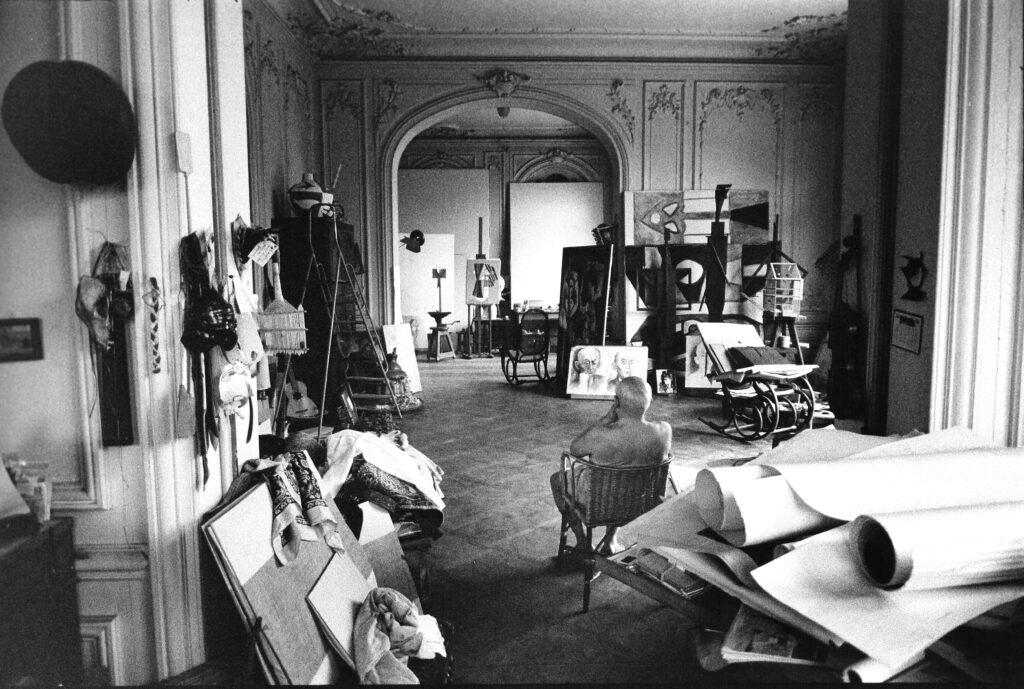
David Douglas Duncan, Picasso dans son atelier regardant Tête. juillet 1957 © David Douglas Duncan_Sucession Picasso 2022
Was it a way to exorcise the Maestro’s fear of dying? Looking at the photos one by one, it is clear that the artist is always at work, brush or pencil in hand. Douglas Duncan immortalizes Picasso’s eye and creative gesture. He takes photographs in profile or over his shoulder, showing the intensity of the moment. To conclude, we want to mention two shots included in the press kit. The first shows two friends seated side by side in front of the lens of Gjion Mili (1960) demonstrating the sense of equality and ease between them. The second represents Picasso seated with his back in the middle of his studio, staring at his canvas entitled Head. The photographer shows us the modesty of his relationship to Picasso and to art. Later, Douglas Duncan confided that it worked well “because I wasn’t an artist, or an art historian… I was just a guy he liked, a guy with a camera. Simply put, we were just two men. It is very important to insist on the fact that I was not an art professional and that was what he expected of me”.

